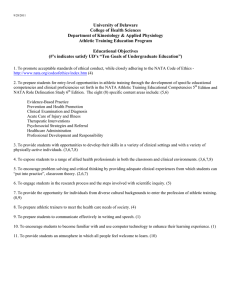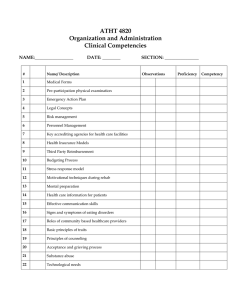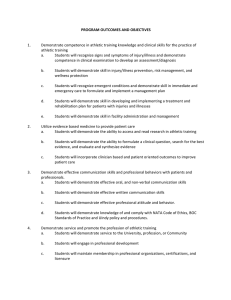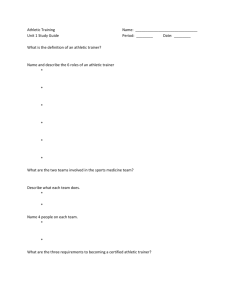College-University Value Model - National Athletic Trainers
advertisement
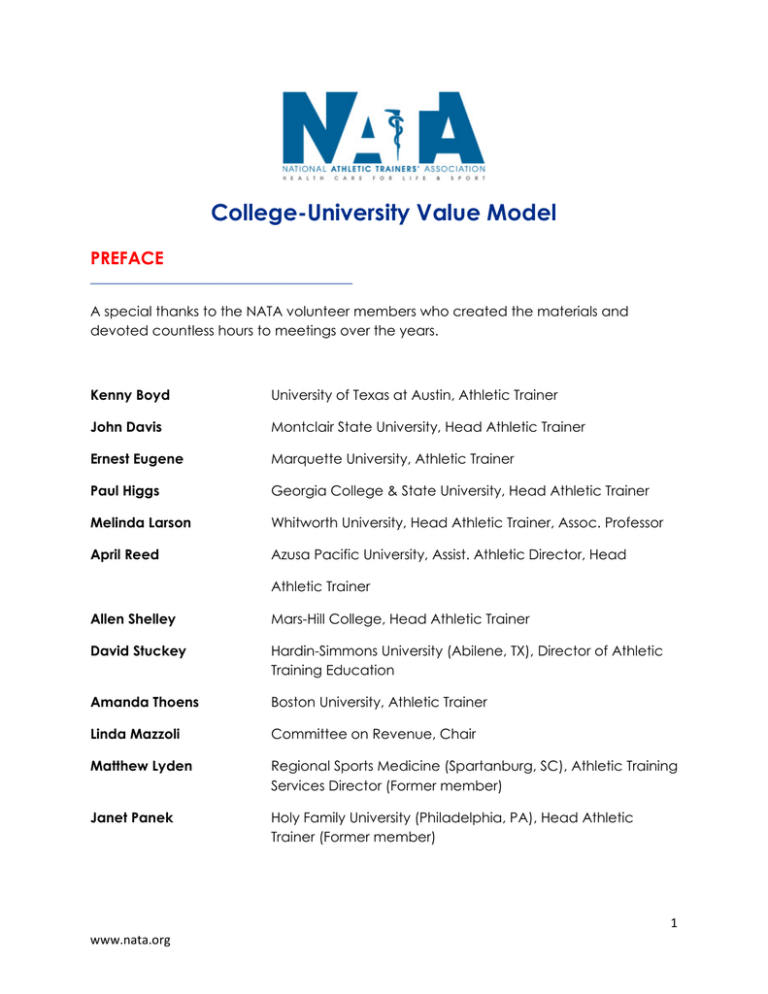
College-University Value Model PREFACE ______________________________________ A special thanks to the NATA volunteer members who created the materials and devoted countless hours to meetings over the years. Kenny Boyd University of Texas at Austin, Athletic Trainer John Davis Montclair State University, Head Athletic Trainer Ernest Eugene Marquette University, Athletic Trainer Paul Higgs Georgia College & State University, Head Athletic Trainer Melinda Larson Whitworth University, Head Athletic Trainer, Assoc. Professor April Reed Azusa Pacific University, Assist. Athletic Director, Head Athletic Trainer Allen Shelley Mars-Hill College, Head Athletic Trainer David Stuckey Hardin-Simmons University (Abilene, TX), Director of Athletic Training Education Amanda Thoens Boston University, Athletic Trainer Linda Mazzoli Committee on Revenue, Chair Matthew Lyden Regional Sports Medicine (Spartanburg, SC), Athletic Training Services Director (Former member) Janet Panek Holy Family University (Philadelphia, PA), Head Athletic Trainer (Former member) www.nata.org 1 TABLE OF CONTENTS ___________________________________ • INTRODUCTION……………………………………………………………..3 • MEDICAL SERVICES…………………………………………………………4 • RISK MINIMIZATION………………………………………………………..8 • ORGANIZATIONAL/ADMINISTRATIVE VALUE……………………..…..11 • COST CONTAINMENT……………………………………….…………….14 • AT INFLUENCE ON ACADEMIC SUCCESS………………….…………..17 • INDEX…………………………………………………………….………….20 • RESOURCES…………………………………….……………………………21 www.nata.org 2 INTRODUCTION ______________________________________ The College/University Value Model is a product of the Committee on Revenue with the College/ University Athletic Trainers’ Committee and in particular the College Value Model Workgroup. The purpose of the College/University Value Model is to: • • • Provide a resource for value assessment for the athletic trainer in the college/university setting Provide unique global revenue strategies for the college/university athletic trainer Serve as a presentation template for the college/university athletic trainer to appeal to non-member administrators It is projected that this information will help ATs maintain and improve their positions by quantifying their worth to the organization. It will serve as a tool to create more jobs in the college/university setting and improve the salaries, benefits and options of those jobs. It will provide an educational tool for ATEP professionals to give future ATs a clear picture of the value they provide as Athletic Training healthcare providers Value or worth may mean different things to different universities. The model will give the answer to the open ended statement “I need to show ………..” Whether that is: we have a cutting edge program useful as a recruiting tool, we need more athletic trainers to provide adequate healthcare, we need to raise salaries to attract high quality employees or that we have provided x number of services to x number of students. For the purposes of the document, the following terms should be considered: Value – the extent to which a service’s worth is perceived Worth – monetary value of a service Revenue – compensations associated either directly or indirectly, with providing athletic training services Reimbursement – payment for providing an athletic training service www.nata.org 3 This value model will help members to articulate the value of all AT professional services in the college/university setting. We hope this material will help our members and others understand the difference between “coverage” and quality athletic health care. The model includes both a PowerPoint presentation for athletic trainers who are giving a formal presentation to a current or potential employer, administrators or governing body and a lengthier document that delves into greater detail on each of the main topics in the presentation. You are your greatest resource when it comes to promoting your services as a professional athletic trainer. We hope that these documents will be your second best resource in guiding you to creating a position that both meets your needs and provides quality healthcare for student athletes. www.nata.org 4 MEDICAL SERVICES Medical services are described as services provided by a healthcare professional to benefit the patient in response to injury/illness management and may include: • • • • • • Injury Evaluation and Treatment Injury Rehabilitation and Reconditioning Management of outside medical providers services Diagnostic testing Team physician services Injury prevention programs Injury Evaluation and Treatment Metrics: Track encounters • Active Student – Athlete • Inactive Student-Athlete (graduated/expired eligibility/medical scholarship) • Faculty/Staff Member/Families • Coaches and their families Injury Rehabilitation and Reconditioning Metrics: Track encounters • Active Student – Athlete • Inactive Student-Athlete (graduated/expired eligibility/medical scholarship) • Faculty/Staff Member/Families • Coaches and their families www.nata.org 5 After Hours/On-Call Consultation and Injury/Illness Management Metrics: Track encounters o Text o Phone Calls • Active Student – Athlete • Inactive Student-Athlete (graduated/expired eligibility/medical scholarship) • Faculty/Staff Member/Families • Coaches and their families Outside Medical Provider Services Metrics: Standard fee vs. Contracted/Reduced fee • Massage • Chiropractor • Nutrition Counseling/Programing • Physical Therapy • Other Manual Therapy • Mental Health o Psych Counseling o Academic Testing o Group Counseling o Catastrophic Event Counseling • Dental Services • Vision Screening o Glasses/Contacts o Dynamic assessment/training • Cardiac Screening • Volunteer consulting services www.nata.org Applying Value Provide an annual/semi-annual report to Senior Administrators regarding: 1. Total Student-Athlete Encounters 2. Injury Management Outcomes 3. Ancillary Services Contracts 6 Team Physician Services • Full-time Physician vs. Contracted Physician o PPEs o In-house General Medical Procedures IV fluids Wound I & D Illness testing (Rapid Strep/Cultures) • Orthopedic Physician Services o Office visits o Surgeries Volunteer consulting services • Diagnostic Testing • Radiologic Services o Weekend/Non-business hour service o STAT readings o Contract rate for frequent imaging (MRI/X ray) • Laboratory Services o SCT Testing o Blood Screening o Drug/Alcohol Testing • Sleep Disorder Testing • Cardiac Screening/Comprehensive Testing Exclusive Medical Provider Contracts • Local Hospital/Urgent Care Facility • Orthopedic Clinic • Emergency Services (Local EMS, EDs) • Specialized orthopedic rehabilitation • Radiologic Services www.nata.org 7 Injury Prevention Programs • Comprehensive Medical Screening • Movement Screening • ACL Prevention Programs • Body Comp Testing • Concussion Baseline o Neurocognitive Testing o Computerized Balance Testing • Pre-participation Exam • Dental Protection o Custom Mouth Guards • Preventative Bracing Programs o Custom Knee and/or Ankle Bracing • Nutrition/Healthy Eating Programs Ancillary Medical Services • Transportation • Club sports coverage/care • Dance/Music Majors • On-campus health clinic coverage • Phlebotomy procedures for testing • In-house radiographic imaging o Limited scope/Extremity xray o Fluroscopy www.nata.org 8 RISK MINIMIZATION Risk minimization involves the process by which identification, analysis, assessment, control and avoidance or elimination of unacceptable risks. These areas can involve the following: • • • • Injury Prevention and Care Policies Emergency Action Planning Maintaining proper certifications for facilities, equipment and personnel Pre-participation medical screening Injury Prevention and Care Policies • Coaches annual education initiatives • Student-Athlete annual education initiatives Environmental Monitoring • Liaison to local monitoring group • Commercial monitoring system • Staff, Departmental and Student-athlete education sessions Emergency Action Plans • Involve those who are going to be involved o Paramedics/EMT/Director of EMS Services o Level 1 Trauma/Local Emergency Department o Campus police o Coaches o Administrative staff o Student-Athletes Movement assessments for pre-existing conditions • Coordination of screening measurements • Interpreting and management of screening outcomes Mental Health counseling referrals • • www.nata.org Identification and management of Mental Health Providers Development of departmental policy that coincides with the University policy on Mental Health Crisis Management 9 Nutrition suggestions and referral • Student-athlete and Coaches education • Compliance with NCAA regulations on permissible nutritional items Safe Facilities • Comply with departmental/university regulations for maintaining of appropriate environment Create/Maintain appropriate medical referral system Review epidemiologic and current evidence-based research for clinical outcomes assessment • Outcome measures o Global Rating of Change (GRC) o Lower Extremity Functional Scale (LEFS) o Disability of the Arm, Shoulder and Hand (DASH) o Kerlan-Jobe Orthopedic Clinic Shoulder & Elbow Score (KJOC) Design and application of preventative and post-injury taping, bracing and padding Protective Equipment selection, fitting and use Recommendations for sport rule changes Make appropriate play/no-play decisions • Code of ethics First Aid/CPR/AED/Airway Management training Infection control • • CDC recommendations Meet with university student health and plan together Facilitate Pre-participation examinations Appropriate Sport Coverage • • www.nata.org Proper staffing in accordance to AMCIA recommendations Education of coaches and staff regarding anticipated response and management of potential injuries/illnesses 10 Substance Abuse Management • • Knowledge of and recommendations for institutional and governing body drug testing Compliance with departmental substance abuse policy Additional Risk Minimization Considerations • Budget management to provide adequate resources to purchase riskreduction supplies • Using communication and interpersonal skills to create trust between student-athletes, coaches, administrators and the athletic training staff www.nata.org 11 ORGANIZATIONAL / ADMINISTRATIVE VALUE Organizational/Administrative Concepts can include: • Injury Records/Electronic Medical Records System Management • Professional Credential Management – CEU – BOC and/or state practice acts and/or rules and regulations per certifying governing body • Pre-participation Examination (PPE) • Sports Medicine Team relations • Emergency Action Plans (EAP) – development and training • Health and Liability Insurance Management • Quality Control • Substance Abuse Education and Testing Program • HIPPA/FERPA Compliance Injury Records • Risk management • Sports medicine team communication • Governing body compliance (medical hardship, PPEs, etc.) • Professional standards compliance • Injury surveillance – injury prevention • Research Credential Maintenance • Maintaining current athletic trainer(s) license/certification to allow practice according to state law • First aid/CPR training for athletics department staff(Compliance with governing body rules and/or NCAA Sports Medicine Handbook recommendations) www.nata.org 12 PPE/Medical History • Risk management • Compliance (governing body rules/ NCAA Sports Medicine Handbook recommendation) • Professional standards compliance • Identification of predisposition for injuries/illnesses which could lead to timeloss and subsequent athletic department medical expenses • Identification of pre-existing unidentified injuries/illnesses (asthma, previous injuries, etc.) • HIPPA/FERPA management and compliance Sports Medicine Team Relations • Determining and validating staffing needs to supervisors • Creating job descriptions for sports medicine team members • Supervising sports medicine team members according to organizational chart • Establishing and maintaining relationships with physicians and other medical/allied health providers and their office staffs • In conjunction with supervising physician(s), establishing standing orders or treatment protocols as may be required by professional standards or state practice acts • Coordinating on-campus physician clinics and/or event coverage • Triaging student-athlete and faculty/staff injuries/illnesses to determine if patient needs referral to physician (reduces unnecessary load in physician’s office and unnecessary medical expenses for athletics department) • Scheduling student-athlete (and faculty/staff) appointments for physician evaluation, laboratory, imaging studies and surgery • Working with physicians to determine appropriate on-campus clinical procedures (suturing, IV fluids, rapid flu testing, etc.); these procedures could reduce athletic department medical expenses www.nata.org 13 Emergency Action Plans (EAPs) • Working with appropriate sports medicine team, university and public safety agencies to create and implement venue-specific EAPs • Professional Standards Compliance (NCAA Sports Medicine Handbook/position statements) • Risk management • Coordination of EMS event coverage • Verifying appropriate EMS access in new facility designs Insurance • Advise athletic administrators, business office or other university staff on issues related to appropriate athletics insurance coverage • Monitor utilization of athletic department insurance benefits • Work with providers to utilize practice methods which can decrease expenses • Assist with creation of discount arrangements with outside medical/allied health services providers • Assist and/or manage filing of insurance claims (what % of your time) • Initial point of contact with NCAA Catastrophic Insurance plan Quality Control • Together with other sports medicine team members, continually assesses whether care being provided meets current standards utilizing evidencebased practice guidelines when available • Evaluates clinical results of other sports medicine team members • Ensures sports medicine team is following appropriate professional standards/position statements relevant to the provision of quality care • Participation in continued education and use of evidence based practices Drug Testing • Assists in creation of drug testing policy • May coordinate drug testing program with testing agency/compliance office • Serves as point of contact for NCAA drug testing program www.nata.org 14 COST CONTAINMENT Cost Containment in the College/University setting can involve departmental and University level administrators. Does your department/university have a Cost Containment department? Policy? Initiatives? Other cost containment ideas can involve: • • • • • Insurance premiums Professional Liability Insurance Staffing/workload management Fund raising Creative budget management Insurance Premiums Intercollegiate Sports Policy (ICS) • Negotiated provider rates below usual and customary • Tiered percentage reduction based on when payment is received (under 30 days) • Student Accident and Health with same provider as ICS (hard waiver or compulsory) • ICS benefit in Student Accident to cover ICS deductible • Personal primary insurance requirement for all student athletes • Where does your premium rank compared to similar institutions? • Familiar with NEW Federal regulations (Affordable Care Act) • Can you demonstrate stability or show a decrease in your premium? • Athlete with strict HMO sent home for surgical intervention in order to receive full benefits, or negotiate an acceptable out of network benefit www.nata.org 15 Professional Liability Insurance • Policies and procedures established for risk minimization • • • Facility and playing environment safety assessment and management Summer camp, All-star game, High School Sport Playoffs, General Contract AT work for remuneration Volunteer activities practicing athletic training separate from institution Staffing and Workload Management • Appropriate Medical Coverage of Intercollegiate Athletics (AMCIA) Calculation o How many FTEs needed? o How many FTEs by existing staff? • Additional staff provided as part of contract with medical director • Medical services provided on or off campus, but will only bill personal primary insurance Medical Services • Track all encounters and contacts • Attach billing codes • Formulate a metric total for all services provided “in house” instead of outside billing • Injury prevention programs Applying Value Utilize injury tracking software capable of generating reports with billing codes. If the software is not capable of attaching billing codes, work with a local clinic to generate totals. Are you and your staff receiving credit for the total healthcare provided? www.nata.org 16 Budget Management • Bid process • Make/Repair equipment as opposed to purchasing from manufacturer • “In house” repairs and renovations completed by athletic training staff • Coordination with Institutional Facility/Maintenance Staff for warranty/maintenance contracts Applying Value Receive multiple bids from reputable distributors, and make sure extended pricing is exact. Distributors should cover freight. Are you tax exempt? Are there other programs on campus in need of similar equipment? Fund Raising • Monetary Donations o Donations for equipment and supplies o Donations for staff development o Donations for student professional development • Service Donations o EMS standby coverage for events o Custom mouth guards and brace fitting o Computer neurocognitive testing license fee o Computer neurocognitive testing support o Physician and/or other medical services provided without expense or contracted with a nominal retainer o Injury Tracking Systems (Free NCAA Injury Surveillance System) • Grants o Foundations o NCAA Health and Safety Grants o NCAA Speaker Grants o Technology Grants www.nata.org 17 ACADEMIC SUCCESS ______________________________________ How does an athletic trainer relate to the academic success of an athletic department and/or it’s student-athletes? • • • • Academic success of the student-athletes Student-athlete retention influencing a better Academic Progress Rate (APR) Contribution to the Life Skills program for student-athletes promoting better health and wellness Mentorship program for Athletic Training Students Academic Success • Retention equals revenue • Retention equals consistency and athletic success • Increases tuition revenue • Increases the number enrolled in student insurance plans Applying Value The more students enrolled in the various insurance policies, the more money there is available to offset the cost of the ICS premium. Student Retention/Academic Progress Rate (APR) • Recognition of potential problems and issues inhibiting student-athlete retention o Trouble in classes o Issues with professors o Determination of Major • Liaison and referral to campus services: career center, learning center, student life • Impartial observer whose jobs are not based on win/loss records. Studentathletes seek ATs out for advice beyond injury management • Often in the best nonbiased position to assess potential risks to academic progression/retention www.nata.org 18 Life Skills • Mentoring as a role model and instructor in healthy lifestyle choices • Recognition of potential problems and issues related to life skills o Communication issues ( Dating, roommates, family, friends, team dynamics) o Conflict resolution issues o Housing Issues o Dating/relationship problems o Career decisions o Job/financial issues o General Healthcare and well being o Life Balance o Time management o Stress management o Life challenges/tragedies o Homesickness • Liaison to campus services, i.e.: career center, student life, mental health/counseling center • Treatment or assistance with care of non-sport related conditions that can affect play and continued academic engagement: o Depression o Eating disorders o Self-mutilation o Self-disclosed or test-revealed substance use/abuse issues • Relationship between student-athlete and AT relies on personal interaction and continued interaction much like that of an academic advisor Conditions Affecting Learning • ADHD • Liaison and follow-up with MD and school services • NCAA compliance/documentation of prescribed medications • Assessment of the impact of side effects of prescribed medication on athletic participation and academic success www.nata.org 19 Counseling • Mentoring as a non-peer, non-coach, non-parent resource with insight in human growth and development • Recognition of potential problems and issues o Relationship issues (dating, roommates, family, friends) o Eating disorders o Psychological/Emotional problems o Sport Psychology Performance Injury related o Grief management o Crisis management • Referrals to coaching staff • Referrals to campus and other professional services when necessary www.nata.org 20 INDEX ______________________________________ ACADEMIC SUCCESS Insurance ADHD Insurance Premiums ADMINISTRATIVE VALUE INTRODUCTION After hours Liaison to campus services Ancillary medical services Life skills Budget management MEDICAL SERVICES Mental Health Counseling referrals Conditions affecting learning Nutrition suggestions and referral COST CONTAINMENT Counseling Outside Medical Provider Services Credential maintenance Policies Practice/event coverage Diagnostic Testing Drug Testing Pre-participation examination (PPE) Education Professional standards compliance Emergency Action Plans (EAPs) Quality Control Environmental monitoring Rehabilitation and Reconditioning Exclusive medical provider contracts Research First Aid/CPR training Return to play decisions Fitting & Use - Protective Equipment RISK MINIMIZATION Safe Facilities Functional Movement Assessments Fund Raising Sports medicine team communication Governing body compliance (medical hardship, Staffing and Workload Management PPEs, etc.) Student Retention/APR Grants taping, bracing Infection control Team Physician Services Injury Evaluation and Treatment Treatment of non-sport related conditions Injury prevention programs Resources Injury records Injury surveillance - injury prevention www.nata.org 21 RESOURCES ______________________________________ NATA Revenue Resources: www.nata.org/revenue-resources College-University Value Model Terminology: Value, Worth, Revenue, Reimbursement National Provider Identifier (NPI) State Regulatory Boards Committee on Revenue Contacts Appropriate Medical Coverage of Intercollegiate Athletics (AMCIA): www.nata.org/appropriate-medical-coverage-intercollegiate-athletics College/University Athletic Trainers’ Committee: www.nata.org/CUATC “10 for 10” Coaches Education Presentations Crown of Helmet Contact Letter NCAA Football Rules Committee Presentation Board of Certification (BOC) for the Athletic Trainer: www.bocatc.org Resources: Role Delineation Study/Practice Analysis; Standards of Professional Practice BOC Facility Prinicples: www.bocatc.org/resources/facility-principles NCAA Sports Science Institute: www.ncaa.org/wps/wcm/connect/public/ncaa/ssi Datalys Center – Sports Injury Research and Prevention: www.datalyscenter.org Disability of the Arm, Shoulder and Hand (DASH) Outcome Measure: www.dash.iwh.on.ca www.nata.org 22
